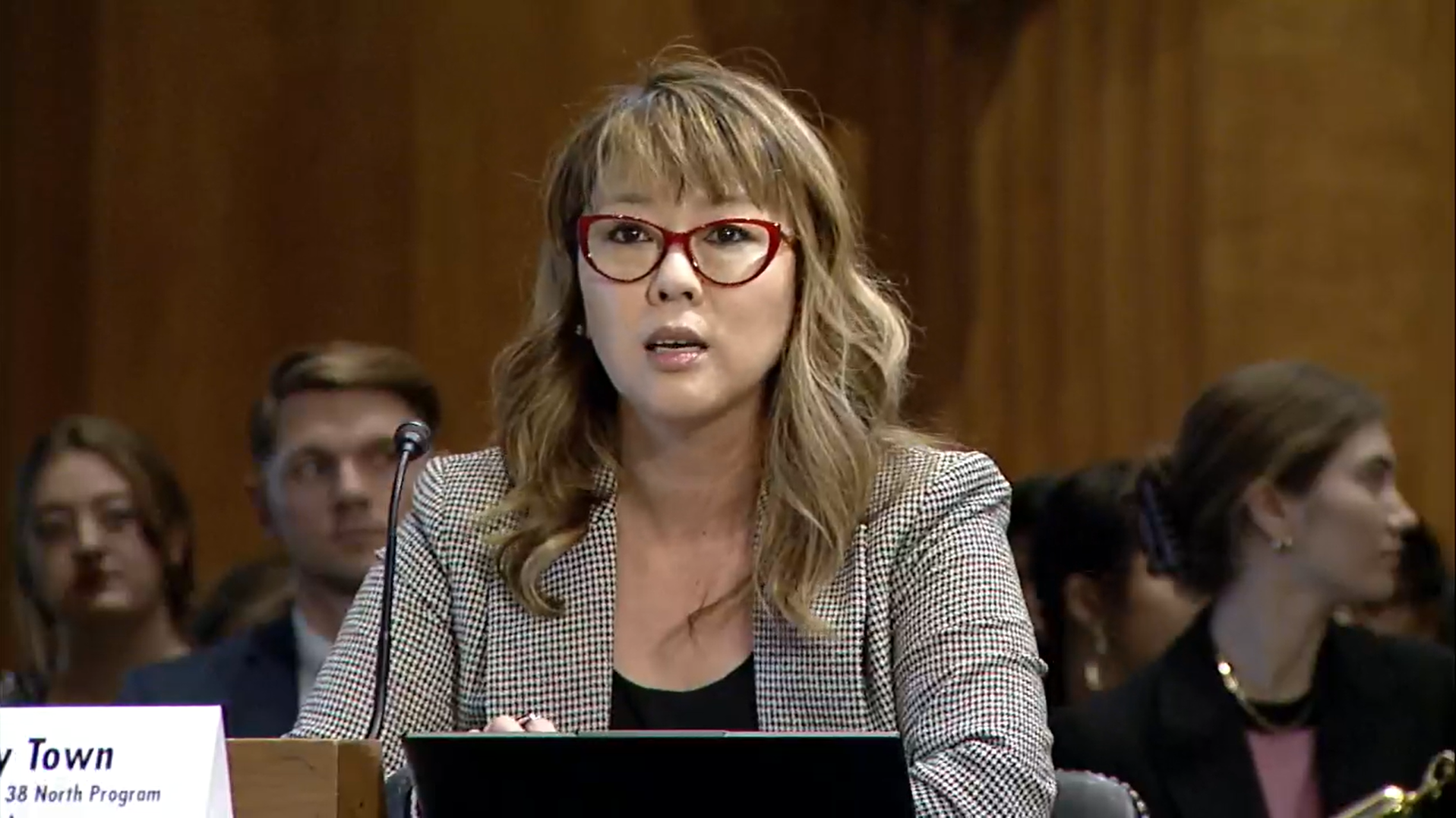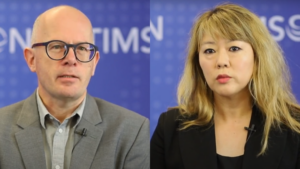Subcommittee Chairman Van Hollen, Ranking Member Romney and distinguished members of the Subcommittee, it is a distinct honor to be able to testify this afternoon, about the growing challenges to security on the Korean Peninsula. The recent summit between Russian President Vladimir Putin and North Korean leader Kim Jong Un at the Vostochny Cosmodrome, was a stark reminder of how the geopolitical trends in the region are shifting as well as the cost of passive diplomacy toward North Korea.
This was by no means a surprising development; signaling between Russia and North Korea has been deepening for some time now, especially since Russia’s invasion of Ukraine. Kim is one of the few leaders who has consistently and openly supported Putin’s war, pledging both political and tactical support—a commitment that came at little cost to North Korea, but was sure to be rewarded.
On the heels of the trilateral summit between the United States, South Korea and Japan at Camp David, Moscow’s willingness to host Kim at the space launch facility and openly engage North Korea on rocket and satellite technologies, fighter jets and other military technologies, appears to signal more than just a potential arms deal in the works to help prolong Russia’s warfighting ability in Ukraine. These developments suggest a sense of reciprocal high level political signaling, but that Putin sees a role for North Korea in Russia’s larger “war against the West”—a proposition that could help North Korea accelerate its WMD development.
That said, the way Russia-North Korea relations have evolved in recent years illustrates the importance of finding ways to rebuild diplomacy with North Korea. While Pyongyang is not sending signals it is open to diplomacy with the United States, especially on nuclear issues, waiting for it to do so would be a serious mistake.
A Look Back: Missed Opportunities
The Hanoi Summit in 2019 was a major window of opportunity for US-DPRK relations, one that is unlikely to be replicated in the foreseeable future. Not only was Kim Jong Un still willing to negotiate about the DPRK’s nuclear weapons program, but there was high level political will in South Korea and the United States to try to facilitate that process in mutually beneficial ways. China and Russia were also supportive of these diplomatic efforts, although carving out their own interests along the way.
An agreement at that time, even if not ideal, would have created a starting point for cultivating cooperation, building trust and providing a basis for testing each party’s resolve: what were the various parties willing to do to reap the benefits of better relations? How far we they willing to go? From enhanced regional security and stability to economic development and integration, to confidence and security building measures that could pave the way for more substantive progress on denuclearization or even arms control talks on the Korean Peninsula, the possibilities at the time under that particular cast of leaders, seemed promising.
While cautious optimism was warranted, there were signs that Kim Jong Un saw a real opportunity to explore cooperation. To create a political environment conducive to and build momentum for diplomacy, Kim took a number of positive unilateral steps ahead of the first US-DPRK summit in Singapore, including a self-declared moratorium on nuclear and long-range missile testing, the return of US detainees, partial demolition of the country’s nuclear test site, and partial dismantlement of the country’s main rocket launch pad, the latter of which closed loopholes in disputes between rocket launches and missile launches that had derailed agreements in the past. Domestic measures were also taken, including the elimination of anti-US propaganda as well as a buildup of domestic expectations that a diplomatic breakthrough was on the horizon that would bring about greater economic development. Even after Singapore, North Korea was quick to act on the return of US POW/MIA remains as the one concrete action item stipulated in the Singapore Joint Statement.
While US-DPRK relations were in good standing, inter-Korean relations also evolved quickly. For instance, with one inter-Korean summit already under his belt, Kim hosted South Korean President Moon in Pyongyang in September 2018, allowing him to speak to a live North Korean audience, hosting K-pop exhibitions in Pyongyang (cultural exposure that had historically been banned), and even standing on the top of Mt. Paektu, hands raised to show that the two Koreas were moving forward together. North Korea’s willingness to both negotiate and start to implement the inter-Korean Comprehensive Military Agreement also showed a level of good will, cooperativeness, and eagerness to move forward that hadn’t existed in decades.
These measures all came with hefty political risk, especially for Kim. Not only was it his diplomatic debut, but the live domestic coverage of the summits and the raising of domestic expectations was a big gamble—one that eventually, did not pan out. The inability to come to agreement in Hanoi was consequential and meant the collapse of inter-Korean talks as well, as Seoul was unable to move forward with an ambitious cooperation agenda. Not only was there a price to pay by both those advising and negotiating on the North Korean side, but efforts were needed to spin the diplomatic efforts as a success while tamping expectations back down about the country’s future. By the end of the year, when no further progress was made on defining an acceptable first step agreement, Kim’s disillusionment with negotiating with the United States was palpable and rhetoric started to shift toward a “new way,” one that set forth a plan to make the economy more resilient to a persistent sanctions regime and that appeared to focus diplomatic energy on more like-minded states, where the potential benefits of cooperation were lower but easier to attain.
Implications for Resuming Nuclear Negotiations
The prospects of recreating the conditions that lead to the summitry of 2018-2019 are extremely low for the near-term.
North Korea’s View of Nuclear Weapons
The biggest obstacle to resuming negotiations about denuclearization of the Korean Peninsula is that Pyongyang’s attitudes toward its nuclear weapons program have fundamentally changed. Alongside the announcement of its new “Law on DPRK’s Policy on Nuclear Forces” in September 2022,1“DPRK’s Law on Policy of Nuclear Forces Promulgated,” Naenara, September 9, 2022. wherein North Korea described itself as a responsible nuclear state and outlined conditions under which it would consider nuclear use, North Korean rhetoric about its nuclear weapons program also shifted. While past descriptions of the country’s nuclear weapons were posed as contingent on the United States maintaining its hostile policy against the DPRK, leaving the door open to negotiations, Kim Jong Un’s speech to the Supreme National Assembly denounced future negotiations to this end, adding “We have drawn the line of no retreat regarding our nuclear weapons so that there will be no longer any bargaining over them.”2Note: “Respected Comrade Kim Jong Un Makes Policy Speech at Seventh Session of the 14th SPA of DPRK,” Rodong Sinmun, September 9, 2022. Just last week, Kim announced that a constitutional amendment had been passed that “ensures the country’s right to existence and development, deter war and protect regional and global peace by rapidly developing nuclear weapons to a higher level.” He explained how the country’s nuclear weapons were for self-defense against a “protracted confrontation with the U.S…. and its vassal forces” and stressed the need for “exponentially boosting the production of nuclear weapons and diversifying the nuclear strike means and deploying them.”
Alignment with China and Russia and Embracing a “New Cold War”
From about 2021 on, North Korea has embraced the suggestion of a “new Cold War” and its alignment within it, deepening its ties to China and Russia. This, as some scholars have noted, marks a “fundamental shift away from the North’s 30+ year policy of nonalignment with China or Russia and efforts to normalize relations with the United States.”
Moves were swift to strengthen relations with China and Russia, with the North Korean defense minister pledging in 2022, “strategic and tactic[al] coordinated operations with the Chinese army, and Kim Jong Un touting a new level of “strategic and tactical cooperation” with Russia. The inclusion of tactical cooperation was new in both instances.
North Korea has certainly benefited from these alignments, especially as the United States strengthens both bilateral and trilateral security cooperation with South Korea and Japan. China and Russia, embroiled in competition with what they perceive as a US-led or West-led security bloc in the region, have viewed North Korea as an important security partner. They have provided political cover for North Korea at the UN Security Council, blocking any attempts at imposing new sanctions for Pyongyang’s continued WMD testing, and have resumed exports and aid to North Korea, with little clarity on what Pyongyang provides in return. In Russia’s case, there have been multiple US intelligence leaks of transfers of arms and munitions from North Korea. While China is a major partner to North Korea these days, especially economically, North Korea has made clear that Russia is currently its primary focus. The differentiating factor here appears to be who can provide Pyongyang the greatest benefit in the short-term. China is still conscious of its international reputation, which constrains the type and depth of cooperation it is willing to openly engage in with North Korea. Russia, on the other hand is less sensitive to international pressure and condemnation due to the country’s growing pariah status and has proven willing to openly cooperate in both economic and military terms.
North Korea is the only United Nations member that recognizes Crimea, Donestsk, Lugansk, Zaporizhzhia and Kherson as Russian territories, and its willingness to provide tactical support for war efforts speaks volumes. Moreover, some scholars suggest that South Korea’s efforts to support Ukraine, even if indirectly, and arms provisions to Poland, likely play some role in Moscow’s calculus as well.
The potential benefits of cooperation with Russia to North Korea are more obvious spanning from food and oil imports in exchange for services such as skilled labor (construction workers), to a range of conventional and/or strategic technologies, parts or components, raw and composite materials for its missile programs or even military industry, and more. Moreover, given Pyongyang’s call for exponential expansion of its nuclear arsenals and its limited capacity to produce plutonium in particular, given its one 5 Megawatt plutonium production reactor, Russian technical assistance in getting the long-stalled Experimental Light Water Reactor (under construction since 2011) running and weaponized, or even direct, clandestine supply of plutonium cannot be ruled out.
Whether Russia is truly willing to go that far to help North Korea ramp up its WMD capabilities is yet to be seen. At the same time, the possibility that it could demonstrates an urgency for Washington to find new ways to engage North Korea.
Rebuilding Diplomacy with North Korea
Rebuilding diplomacy with North Korea has to start with the fundamental recognition that North Korea has its own national interests and will act accordingly. It is an insecure country among political, economic and military giants. While it possesses nuclear weapons, constant reminders of how the United States and its allies can bring about “the end” of either the state or the regime only fuels that insecurity and feeds North Korea’s conviction in its choices.
Deterrence alone will not reduce nuclear dangers posed by North Korea, as Pyongyang responds to power with power. Relying on deterrence messaging, using overly aggressive or increasingly muscular language, emphasizing pressure on the North, or pursuing any concession that is achieved through what Yun and Aum describe as “reluctant submission rather than its motivated self-interest,” will not be meaningful or sustainable. They note, the biggest flaw in US policy “is the belief that the United States can somehow bully North Korea into giving up its nuclear weapons.”
This notion that we can force North Korea to a point where they must choose between denuclearization and survival belies the extent to which North Korea has been able to adapt to the various restrictions imposed upon it, find partners willing to violate or ignore unilateral and/or international sanctions, and endure suffering along the way for what it perceives as a just cause.
Furthermore, continuing to pursue a denuclearization-centered approach means Washington will be left standing by the wayside for some time, passively watching North Korea’s continued development of its nuclear and ballistic missile capabilities and, especially now, deepened security partnerships along perceived Cold War alignments—all developments that increase uncertainty and instability in the region and pose further challenges to US and allied relations.
This is especially true as an arms race is accelerating in Northeast Asia. Expecting North Korea to see denuclearization as a pathway to either greater prosperity or increased security while the rest of the region arms up is setting ourselves up for failure, especially when there is such a trust deficit between our countries.
The United States has clearly given thought and attention to US and allied defenses and cooperation and has demonstrated great resolve and commitment to our mutual defense and extended deterrence commitments. However, that is only one part of the equation and in the absence of diplomacy, risks exacerbating competition and adversarial relations in the region.
Equally important, however, is the need to rebuild diplomacy with North Korea. As a former witness testified previously, previous failures should not preclude additional diplomatic attempts to reduce the North Korean nuclear threat.3Prepared remarks of Bruce Klingner, “North Korea Policy One Year After Hanoi,” Subcommittee on East Asia, the Pacific, and International Cybersecurity Hearing, Committee on Foreign Relations, United States Senate, February, 25, 2020, p. 19. At the same time, new approaches need to better reflect the realities of where our relations are today and the broader geopolitical context in which it takes place. This will require a reframing of our goals and some truly creative thinking about a strategy to achieve them. Some principles to consider include:
- Recognize acts of goodwill and reciprocate: Reciprocating North Korean acts of goodwill can potentially create small windows of opportunity to reopen channels of communication and help identify ways to deescalate tensions. For example, North Korea’s return of Travis King took diplomatic coordination across multiple stakeholders, but the result was the best possible outcome for all those involved. While there is nothing formally expected in return for King’s release, some small reciprocal gesture could help reinforce this positive development.
- Gear up for diplomacy: North Korea may be small and poor, but its weapons development impacts the regional and global security environment in disproportionate ways. While the US is focused on bolstering extended deterrence to assure our allies in the region against growing North Korean WMD capabilities, that assurance will always be a bottomless pit until the threat has abated. For such a challenge, the Biden administration needs more than just a part-time special representative to spearhead efforts. This posting has been, and should be, reconstituted as a full-time position, working to create new opportunities to reengage Pyongyang and coordinate interagency efforts. This is especially important now as a new Special Envoy for North Korean Human Rights begins her tenure.
- Determine short-term goals beyond denuclearization: While the Biden administration has conveyed several invitations to the North Koreans for unconditional talks, the perception is that the subject of talks—either explicit or implicit—is denuclearization. While denuclearization of the Korean Peninsula should remain a long-term goal, including the prevention of South Korea from pursuing nuclear weapons, there is greater urgency at the moment to reduce tensions and avoid endless arms racing and nuclear war. While it is unclear what topics Pyongyang might respond to, probing interest across a range of issues in either bilateral or multilateral formats could prove useful, especially as US-China relations begin to thaw.
- Build concrete proposals to manage expectations: It seems unlikely that Pyongyang will see the prospect of re-engaging with the United States in long, drawn out negotiations that may or may not result in an agreement as compelling. One reason it favors Russia in the current environment is that engagement poses little political risk and high reward for Kim Jong Un. Convincing Kim that there are benefits to better relations with the United States will take more explicit proposals, even in the invitation phase, to set bounded expectations of what the purpose of talks will be, what is on the table to be gained—preferably with little negotiation—and what longer-term goals this interaction could feed into. Building North Korea’s confidence that reasonable results are possible within a short time frame, may lower the perceived political risk of engagement and create new opportunities.
- Clear pathways for informal engagement: As North Korea emerges from its prolonged COVID-related isolation, opportunities to engage at informal levels become possible again, such as humanitarian work and Track 2 engagement. While there is currently no guarantee when the North Koreans may be willing to resume these types of engagements, the US government could work to clear out some of the bureaucratic hurdles, such as those outlined in H.R. 1504/S. 690 on Enhancing North Korea Humanitarian Assistance Act, involved in pursuing this work to help organizations and individuals be ready to act when the opportunity arises.
- Recalibrate the scope, scale, and frequency of Joint Military Exercises: Military readiness is important, especially when tensions are high, and managing combined forces in action is complex. That said, the strategy of back-to-back exercises for months on end, some standard and some reactive to North Korean actions, should be reassessed. At what point do actions become excessive or even counterproductive? While North Korea often objects to joint military exercises in general, recent statements have more specific complaints about the “aggressive provocation of the U.S. far beyond its constant military readiness,” and drills that “continue all the year round, day after day and month after month, with the involvement of huge war hardware specially targeted on a country.”4“Press Statement of Kim Yo Jong, Vice Department Director of C.C., WPK,” KCNA, July 14, 2023. ,5“U.S.-led Hostile Forces’ Ceaseless War Provocations Under Fire,” KCNA, May 19, 2023.
- Better manage messaging about extended deterrence and military exercises: Coordinating public messaging across allies is a challenging task, but one that is important to alliance management as well as messaging to adversaries. Constantly portraying drills as the “largest ever” or using terms like “annihilation drill” can be unnecessarily aggressive. Moreover, finding ways to make information about alliance consultation institutions and processes more transparent and accessible, such as a dedicated alliance-focused website, could help convey to the general public a sense of deep, ongoing cooperation without the confrontational messaging.
Conclusion
North Korea’s nuclear ambitions have proven resilient to pressure and enduring, especially as the security situation in the region becomes more dangerous. Strengthening US and allied defenses, and extended deterrence coordination and consultation are important to the protection of our common and collective interests. But this is just one part of the equation. Rebuilding diplomacy with North Korea is equally important to reducing the risks of nuclear conflict—whether intentional or accidental—and to curbing endless arms racing in this vital and dynamic region. For the United States, this will take creative, concerted and persistent efforts to bring about, and some early wins up front to keep our foot in the door. Failing to do so could have serious implications for security on the Korean Peninsula.
Watch the full testimony
Notes
- 1“DPRK’s Law on Policy of Nuclear Forces Promulgated,” Naenara, September 9, 2022.
- 2Note: “Respected Comrade Kim Jong Un Makes Policy Speech at Seventh Session of the 14th SPA of DPRK,” Rodong Sinmun, September 9, 2022.
- 3Prepared remarks of Bruce Klingner, “North Korea Policy One Year After Hanoi,” Subcommittee on East Asia, the Pacific, and International Cybersecurity Hearing, Committee on Foreign Relations, United States Senate, February, 25, 2020, p. 19.
- 4“Press Statement of Kim Yo Jong, Vice Department Director of C.C., WPK,” KCNA, July 14, 2023.
- 5“U.S.-led Hostile Forces’ Ceaseless War Provocations Under Fire,” KCNA, May 19, 2023.




